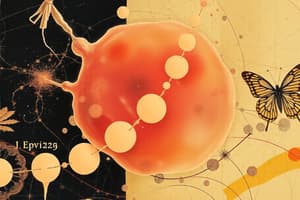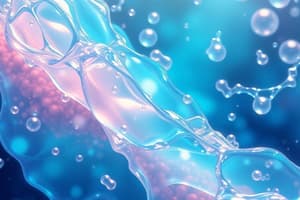Podcast
Questions and Answers
What is the primary solvent used to dissolve chitosan in the synthesis of chitosan–Chlorella hydrogel beads?
What is the primary solvent used to dissolve chitosan in the synthesis of chitosan–Chlorella hydrogel beads?
- Glacial acetic acid (correct)
- Ethanol
- Distilled water
- Sodium hydroxide solution
What is the purpose of using NaOH solution in the synthesis process of chitosan–Chlorella hydrogel beads?
What is the purpose of using NaOH solution in the synthesis process of chitosan–Chlorella hydrogel beads?
- To dissolve Chlorella powder
- To neutralize the pH of the solution
- To facilitate the gelation process (correct)
- To remove impurities from chitosan
How long were the chitosan–chlorella beads left in NaOH solution for gelation?
How long were the chitosan–chlorella beads left in NaOH solution for gelation?
- 1 hour
- 4 hours
- 2 hours
- 3 hours (correct)
What technique is used to characterize the materials of the dried chitosan and hydrogel beads?
What technique is used to characterize the materials of the dried chitosan and hydrogel beads?
What is the weight ratio of KBr to the blended powder for FTIR analysis?
What is the weight ratio of KBr to the blended powder for FTIR analysis?
What is the initial environmental condition for measuring the degree of swelling of the hydrogel samples?
What is the initial environmental condition for measuring the degree of swelling of the hydrogel samples?
What kind of solutions are used for the swelling media during the swelling measurements?
What kind of solutions are used for the swelling media during the swelling measurements?
What type of microscopy is utilized to investigate the surface morphology of the chitosan–Chlorella hydrogel beads?
What type of microscopy is utilized to investigate the surface morphology of the chitosan–Chlorella hydrogel beads?
What factors were measured to determine the mechanical stability of chitosan–chlorella hydrogel beads?
What factors were measured to determine the mechanical stability of chitosan–chlorella hydrogel beads?
Which intermolecular forces are primarily responsible for the water retention properties of hydrogels?
Which intermolecular forces are primarily responsible for the water retention properties of hydrogels?
What trend was observed in the water retention rate during the first 20 minutes?
What trend was observed in the water retention rate during the first 20 minutes?
How do van der Waals forces and hydrogen bonds influence hydrogels?
How do van der Waals forces and hydrogen bonds influence hydrogels?
What happens to the water retention rate of chitosan–chlorella hydrogel beads after the initial sharp decrease?
What happens to the water retention rate of chitosan–chlorella hydrogel beads after the initial sharp decrease?
What type of analysis was likely used to measure mechanical stability in the study?
What type of analysis was likely used to measure mechanical stability in the study?
Which of the following best describes the relationship between mechanical stability and water retention in the context of hydrogels?
Which of the following best describes the relationship between mechanical stability and water retention in the context of hydrogels?
What occurs during centrifugation that affects the water retention of hydrogels?
What occurs during centrifugation that affects the water retention of hydrogels?
What is the primary benefit of the natural toughness of Chlorella's cell wall in the context of hydrogel beads?
What is the primary benefit of the natural toughness of Chlorella's cell wall in the context of hydrogel beads?
How does the hydrogel network formed with Chlorella improve mechanical stability?
How does the hydrogel network formed with Chlorella improve mechanical stability?
What effect does ultrasonication have on chitosan–Chlorella hydrogel beads?
What effect does ultrasonication have on chitosan–Chlorella hydrogel beads?
What role do intermolecular forces play in the hydrogel network with Chlorella?
What role do intermolecular forces play in the hydrogel network with Chlorella?
What was the outcome of the experiments conducted by Cong et al. on hydrogel beads?
What was the outcome of the experiments conducted by Cong et al. on hydrogel beads?
What effect does Chlorella have on the mechanical stability of hydrogel beads?
What effect does Chlorella have on the mechanical stability of hydrogel beads?
What role do hydrogen bonds play in the structure of hydrogel beads containing Chlorella?
What role do hydrogen bonds play in the structure of hydrogel beads containing Chlorella?
What was concluded about the interaction of Chlorella with the chitosan network?
What was concluded about the interaction of Chlorella with the chitosan network?
How does the content of Chlorella affect the mechanical properties of hydrogel beads?
How does the content of Chlorella affect the mechanical properties of hydrogel beads?
What is the primary function of the cross-linking between Chlorella and chitosan?
What is the primary function of the cross-linking between Chlorella and chitosan?
What does the presence of Chlorella do to the structure of hydrogel beads during centrifugation?
What does the presence of Chlorella do to the structure of hydrogel beads during centrifugation?
What mechanism is involved in dissipating the crack energy in hydrogel beads with Chlorella?
What mechanism is involved in dissipating the crack energy in hydrogel beads with Chlorella?
Which statement reflects the importance of Chlorella in hydrogel beads?
Which statement reflects the importance of Chlorella in hydrogel beads?
What happens to the swelling degree of chitosan–chlorella hydrogel beads as the temperature increases?
What happens to the swelling degree of chitosan–chlorella hydrogel beads as the temperature increases?
How does the concentration of saline solution affect the swelling degree of chitosan–chlorella hydrogel beads?
How does the concentration of saline solution affect the swelling degree of chitosan–chlorella hydrogel beads?
What was studied in relation to chitosan–chlorella hydrogel beads in the provided content?
What was studied in relation to chitosan–chlorella hydrogel beads in the provided content?
Which ionic solutions were mentioned in relation to the swelling behavior of the hydrogel beads?
Which ionic solutions were mentioned in relation to the swelling behavior of the hydrogel beads?
What conclusion can be drawn about the effect of temperature on the swelling of hydrogel beads?
What conclusion can be drawn about the effect of temperature on the swelling of hydrogel beads?
How does high temperature affect the swelling ratio of hydrogel beads with Chlorella content?
How does high temperature affect the swelling ratio of hydrogel beads with Chlorella content?
What effect does ionic strength have on the degree of swelling of hydrogel beads?
What effect does ionic strength have on the degree of swelling of hydrogel beads?
What role do Chlorella cells play in the hydrogel network?
What role do Chlorella cells play in the hydrogel network?
What formula can be used to calculate the influence of ionic strength on swelling in hydrogels?
What formula can be used to calculate the influence of ionic strength on swelling in hydrogels?
Which factor does NOT influence the swelling ratio of hydrogels according to the provided content?
Which factor does NOT influence the swelling ratio of hydrogels according to the provided content?
According to the provided content, a high ionic strength implies what in terms of the hydrogel's characteristics?
According to the provided content, a high ionic strength implies what in terms of the hydrogel's characteristics?
What does 'S' represent in Flory's equation as described in the provided content?
What does 'S' represent in Flory's equation as described in the provided content?
What impact does the presence of Chlorella have on the hydrogel when considering ionic strength?
What impact does the presence of Chlorella have on the hydrogel when considering ionic strength?
Flashcards
Chitosan-Chlorella Hydrogel Beads Synthesis
Chitosan-Chlorella Hydrogel Beads Synthesis
A method of creating hydrogel beads using chitosan and Chlorella.
Chitosan Dissolving Process
Chitosan Dissolving Process
Dissolving chitosan in acetic acid.
Hydrogel Formation
Hydrogel Formation
Creating a gel-like structure by dropping the chitosan and Chlorella mix into NaOH.
Gelation Process
Gelation Process
Signup and view all the flashcards
Washing the Beads
Washing the Beads
Signup and view all the flashcards
FTIR Spectroscopy
FTIR Spectroscopy
Signup and view all the flashcards
Scanning Electron Microscopy (SEM)
Scanning Electron Microscopy (SEM)
Signup and view all the flashcards
Swelling Measurement
Swelling Measurement
Signup and view all the flashcards
Chitosan-Chlorella Hydrogel Beads
Chitosan-Chlorella Hydrogel Beads
Signup and view all the flashcards
Wet Weight Retention
Wet Weight Retention
Signup and view all the flashcards
Ultrasound and Centrifugation
Ultrasound and Centrifugation
Signup and view all the flashcards
Water Retention Rate
Water Retention Rate
Signup and view all the flashcards
Van der Waals Forces
Van der Waals Forces
Signup and view all the flashcards
Hydrogen Bonding
Hydrogen Bonding
Signup and view all the flashcards
Hydrogels
Hydrogels
Signup and view all the flashcards
20 minutes
20 minutes
Signup and view all the flashcards
Chlorella enhanced hydrogel stability
Chlorella enhanced hydrogel stability
Signup and view all the flashcards
Hydrogen bonding in hydrogel
Hydrogen bonding in hydrogel
Signup and view all the flashcards
Weight retention
Weight retention
Signup and view all the flashcards
Cross-linking
Cross-linking
Signup and view all the flashcards
Crack Bridge
Crack Bridge
Signup and view all the flashcards
Mechanical Stability
Mechanical Stability
Signup and view all the flashcards
Centrifugation
Centrifugation
Signup and view all the flashcards
Hydrogel Beads
Hydrogel Beads
Signup and view all the flashcards
Salt Concentration Effect
Salt Concentration Effect
Signup and view all the flashcards
Temperature Effect
Temperature Effect
Signup and view all the flashcards
Why Salt Reduces Swelling?
Why Salt Reduces Swelling?
Signup and view all the flashcards
Swelling Degree
Swelling Degree
Signup and view all the flashcards
Hydrogel Beads: Bigger or Smaller?
Hydrogel Beads: Bigger or Smaller?
Signup and view all the flashcards
Centrifugation Impact on Hydrogel
Centrifugation Impact on Hydrogel
Signup and view all the flashcards
Ultrasonic Fragmentation
Ultrasonic Fragmentation
Signup and view all the flashcards
Water Retention in Hydrogel
Water Retention in Hydrogel
Signup and view all the flashcards
Hydrogel Stability
Hydrogel Stability
Signup and view all the flashcards
Swelling Ratio
Swelling Ratio
Signup and view all the flashcards
Ionic Strength
Ionic Strength
Signup and view all the flashcards
Flory's Equation
Flory's Equation
Signup and view all the flashcards
Cross-link Density
Cross-link Density
Signup and view all the flashcards
Chlorella
Chlorella
Signup and view all the flashcards
Water Retention Property
Water Retention Property
Signup and view all the flashcards
Filling Biomaterial
Filling Biomaterial
Signup and view all the flashcards
Affinity
Affinity
Signup and view all the flashcards
Study Notes
pH-Responsive Eco-Friendly Chitosan-Chlorella Hydrogel Beads for Water Retention and Controlled Release of Humic Acid
- Chitosan-chlorella hydrogel beads were created for controlled release fertilizers using a physical cross-linking method.
- Chlorella improved the mechanical stability of the hydrogel beads under stress, compared to pure chitosan.
- The beads showed greater sensitivity to changes in pH, salt solution, and temperature.
- At 40 wt% Chlorella, water absorption was highest at 42.92 g/g.
- The process of swelling and release of humic acid was pH-dependent.
- The hydrogel beads demonstrated potential in controlled-release carrier systems for biomaterials.
Introduction
- Fertilizers are integral to modern agriculture.
- Fertilizer losses due to volatilization and leaching are significant.
- Controlled-release fertilizers are gaining popularity to minimize losses and environmental impact.
- Hydrogels, particularly polymer-based, can effectively carry and release fertilizers.
- Biodegradable and cost-effective natural polymers are preferred for sustainability.
- Chitosan, a deacetylated chitin derivative, is a widely used biomaterial.
- Chitosan hydrogels have limitations in strength and flexibility.
- Bio-based fillers (like Chlorella) enhance hydrogel performance.
Materials and Methods
- Chlorella powder, chitosan, acetic acid, sodium hydroxide, and humic acid were used.
- Hydrogel beads were synthesized using a step-by-step method including dissolving chitosan in acetic acid, incorporating Chlorella, precipitating the mixture into sodium hydroxide solution, and drying the resulting beads.
- Materials characterization techniques involved FTIR, SEM.
- The degree of swelling was determined through a weight gain calculation.
- Mechanical stability was assessed via centrifugation and sonication.
- Loading and release efficiency of humic acid were evaluated at different pH and temperatures.
Results and Discussion
- The FTIR spectra showed the presence of functional groups in chitosan and Chlorella.
- Chlorella enhanced the physical properties of the hydrogel (surface texture and mechanical resilience).
- The swelling of the hydrogel was affected by pH. Optimal swelling occurred at pH 6-8.
- Swelling behavior was pH-dependent and reversible.
- Various salt solutions impacted swelling characteristics (higher ionic strength correlated to reduced water uptake).
- Temperature had a significant impact, affecting swelling behavior at higher temperatures.
- Pseudo-first-order and pseudo-second-order kinetics models were used to study the kinetics of swelling in water.
- Loading efficiency and release efficiency of humic acid in hydrogel beads were analyzed and affected by pH.
Conclusion
- Chitosan-chlorella hydrogels show enhanced properties compared to chitosan alone, specifically improved mechanical stability, swelling behavior, and controlled release.
- The pH- and temperature-responsive nature of the hydrogels makes them potential candidates for environmentally friendly controlled release fertilizers.
Studying That Suits You
Use AI to generate personalized quizzes and flashcards to suit your learning preferences.
Related Documents
Description
This quiz focuses on the development of pH-responsive chitosan-chlorella hydrogel beads designed for controlled release of fertilizers. Explore the benefits of these beads in enhancing water retention and minimizing fertilizer losses in agriculture. Understand the role of temperature and pH in the efficiency of these biomaterials.




